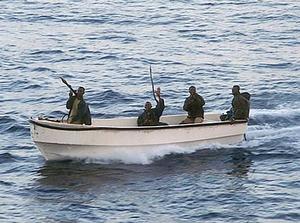PiracyNew radar improves pirate threat detection
New maritime radar helps protects ships again pirates; the radar is effective in detecting small targets, especially in high levels of rain and sea clutter, and it automatically alerts watch keepers about craft displaying hostile behavior patterns

Pirates can now be spotted sooner // Source: offshoreinjuries.com
The value of being able to detect small vessels approaching in any weather conditions, and automatically identify potentially hostile behavior, is highlighted by a report, titled “Confidential Hazardous Incident Reporting Program,” which appears in the 2011 first edition of Maritime Feedback (issue 28), a newsletter from CHIRP.
“Thick low clouds and rain may provide a hiding place for pirate craft,” warns a CHIRP report about an incident in the South China Sea. While passing the Anamabas Archipeligo in the middle of the night, an officer of the watch noticed two small unidentified targets on the radar, and thick low clouds forming and developing in their direction. The targets became lost in rain clutter. Some time later he received a distress call from a tanker in the vicinity advising that it had been boarded by pirates.
The “lesson learned” was that a careful radar watch should be kept on areas of thick low clouds and rain, adjusting range and rain clutter accordingly, the watchkeeper concluded. “While this is good advice, the truth is that, in these conditions, most commercial marine radars will struggle to detect the type of small craft favored by pirates,” Spike Hughes, Kelvin Hughes’s commercial business director, told Maritime Executive. “However, not all radars are the same. Our SharpEye solid state technology is exceptionally effective in detecting small targets, especially in high levels of rain and sea clutter and can prove a valuable tool in the early detection of pirates.
“Furthermore, SharpEye can help to take the strain off radar watchkeepers by automatically alerting them to craft displaying hostile behavior patterns. Pirates typically use boats with very small radar cross-sections and approach their intended victims on a direct track, most often from astern and frequently at night.
“SharpEye’s optional doppler processing means it can extract targets showing certain velocity characteristics. The detection process is completely autonomous of the display system and can be used to drive a MantaDigital display’s second PPI. All targets meeting the velocity filter characteristics will be displayed, with a warning/alarm if required.
“SharpEye provides better detection of small targets than a conventional magnetron radar both because of its improved performance in clutter and by using doppler processing. These two factors combine to provide SharpEye with the best possible threat detection, approaching that of multi-million-dollar military systems, and gives a ship time to take appropriate counter-measures.”
